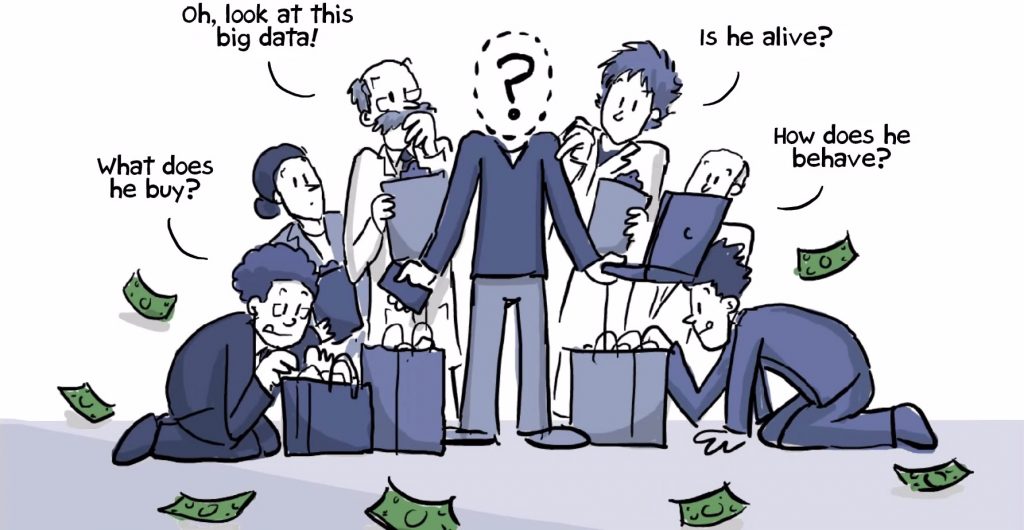Original article published on Hub of All Things.
Today’s corporations use IT to be incredibly efficient and effective. There are IT systems for finance, accounting, inventory management, supply chains, material and enterprise resource planning. All the tools necessary for the corporation be viable and profitable amid constraints of regulation. Corporations hold vast amounts of data to achieve this; data about production, materials, inventory, data about customers. In fact, nothing can be achieved within the modern corporation today without data and information. The corporation is also able to buy digital services of all sorts to analyse, process and make decisions from the data, be it to sort out accounting systems to managing HR. Indeed, many corporations outsource and buy in capabilities that are not core to their competencies.
Today’s individuals also use IT to be efficient and effective. Aided by the Internet, www and our smartphones, we can organise our lives and our families, work from home, have information access at our fingertips. But in terms of computational capability, data and our ability to buy digital services, we are very far behind the corporation. Where they have data on inventory, we barely know what is in our cupboards and fridges. Where they can buy services that augment their abilities, we can just about buy a translator, maps, currency exchange. Where corporations can be omniscient through their devices and sensors, we can just about put up a camera to check on our house remotely.
 Image: Jorge Cham, PhD comics
Image: Jorge Cham, PhD comics
The market doesn’t seem to work in our favour as individuals. More firms are coming into the digital space to share our data amongst one another, asking us for our permission to do so but the revenue models are usually ad-driven or worse, they sell our data, albeit anonymised, to other firms. We are starting to use our Facebook or Twitter identity data to sign on to other digital services and allowing Whatsapp or LinkedIn to tap into our contact list. Essentially, as more digital applications proliferate, the more we are being harvested for our data and the more we are being sold advertising. Two factors contribute to this:
- First, we often place little value on our own data, and are prepared to sign it away for the simplest service e.g. the way we give away browser cookies to peruse a website. It is as though the corporations out there consider our data precious but because we don’t have any use of the data for ourselves, we have little regard for it.
- Second, we also don’t have the computational or system capability to use our data. We don’t have a software platform that enables better wellbeing as well as integrating different data in the way that corporations do. Firms can buy software platforms for enterprise planning, organising and coordinating but we can’t. In addition, human beings use data quite differently from corporations. We cluster data and usage of objects according to our day-to day-contexts. Data from Tesco shopping, car journeys and school pickup are bundled together more meaningfully as a “mummy run” context compared to considering the data in the grocery, automotive and education vertical sectors.
So how do we square this?
The HAT Elevator Pitch
The Hub-of-All-Things (HAT) is a new kind of online data exchange, with you in control. HAT helps you easily capture and generate value from your data. It enables the collection and exchange of digital information, location and personal preferences, for work and leisure activities for example, for the mutual benefit of individuals, families, communities and organisations.
HAT creates a secure personal profile on the Internet, supported by a code of practice and regulated trust framework that enable control of data exploitation in a way that maximises its value to the individual. It saves you time and money by tailoring existing products and services based individual identity.
HAT providers are managed by The HAT Foundation, a consortium of public sector, academic research and industry partners, formed to champion the adoption and regulation of HAT technology.
Making Corporations Out Of Everyone
If corporations have so much computational powers and the ability to buy services, use data effectively and have rights to keep their own data private, then why don’t we just make a corporation out of everyone? Why can’t each person have a server identity, much like an online shop is a server? If our relationship with our host provider is the same type of relationship between Tesco and their server hosting provider, it would certainly be more equitable, as I assume that the host provider would not have a right to poke around Tesco’s data. More importantly, if I decide to change hosts, I can move all my data to a different host. Essentially, I can be my own ‘corporation’ with my own ‘personal resource planning’ platform with inventory of my stuff, data about my health, wellbeing, etc. In fact, HAT Platform Providers (HPPs) are already creating easy ways to buy apps to view, analyse, and organise my data.
As we begin the public release of the HAT in September, through HPPs, to experimental groups of users and later on to a wider community, I am mindful of the implications. We are essentially looking at potentially half a billion people being ‘corporatised’ in a way when they sign on to get their own HATs. And as they do so, they will be empowered to store, analyse and manage their data like they have never been able to do so before. More importantly, they will be able to speak to corporations ‘server-to-server’, API to API, leveraging on a legal framework that binds firm-to-firm relationships in far more equitable way than firm-to-consumer relationships. Some individuals may decide to bring emails back to their own server, since the ontology of the HAT schema flattens data and therefore can help combine email data with other data for better planning, searching and organising. It feels terribly powerful to have your own server, even if what you have to organise is only your own data. The platform will certainly be attractive to developers who can create better applications to help us view, analyse, track and organise our own data that could be combined with third party datasets for better matching or recommendation services.
The amazing thing about the HAT is that as a server, you can also share your data in a “peer-to-peer” manner. This means I can share my location on a realtime basis (e.g. My iPhone location data) with my husband so that when he opens his HAT enables applications, he can see my location that is shared with him and it’s no one’s business except ours. And the apps I buy to view, analyse and organise my data don’t have access to the data itself; it is akin to me buying a piece of software in the old days and installing it on a PC not connected to the Internet. But if I do want to share it, I can just create a data debit (which is the way all HAT data leaves the HAT) and share it with whomever I please. Such is the HAT. A personal resource planning system for the individual. Finally.
A Level Playing Field
Even as we release the HAT over the next six months, I have not missed the irony that the way we have engineered the personal data ecosystem to give control and empowerment back to the individual is to make us look like firms. Turning ourselves into a mirror image of the firm’s digital presence might finally get us respect and fair treatment, within the prevailing legal framework governing business-to-business relationships rather than being treated as passive consumers being harvested for our data. Perhaps. Wouldn’t it be funny to have Amazon concerned about their data being harvested when they come to the HAT platform to provide buying recommendations? But it’s ok. It’s all API to API, so everyone would share exactly what they are willing to share. Such is the equitability of a B2B system.
I believe we have one chance, and the timing is now, at the cusp when the two major industries of manufacturing is colliding with the Internet through the Internet-of-Things. It is now that we can jump in and introduce a system that brings back control to the individual, in a way that is innovation and economy-friendly. With HAT, firms, government and individuals can all work to reimagine the way we own and control our data to their mutual benefit.
What of democracy then? When HAT servers augment and amplify us are we able to interact with governments and firms on a more level playing field? Can we finally get more collective power as a society through better coordination, better collaborative consumption through a standardised platform that enables ours technology to interact whilst remaining uniquely personal to us as individuals with our own data? We wait to see. I have spent more than 20 years helping firms with value, worth, service and their business/economic models to generate more profits. Seems helping individuals to be ‘firm’-like could be a win-win for all with better control for individuals whilst helping create more jobs and greater opportunities in the digital economy.
Finally, I am also mindful of the divide between those who can afford an augmented and amplified self through a server and those who cannot, which could potentially create a bigger divide between the haves and have-nots. As such, the HAT will be available free of charge, up to a degree of storage and depending on who you choose as your HAT host, much like the www is free. Yet, the asset of our own HAT is to have more of our own data in it so that it can be leveraged for services and exchanges. If the wellbeing of society is at stake, then it is in our interest to ensure that everyone, young or old, rich or poor, be given a HAT. Fortunately, the entire ontology, schema and database of the HAT is open-sourced and free for anyone to innovate on. Although if you are a user and do not want to build your own software, you might prefer to just get it off a HAT platform host. In the UK, this would be through Enable iD and in Singapore, through Noggin Asia. More HAT platform hosts are coming soon in other countries so do look out for them. And watch this space out for the HAT white paper on “Why Everyone Should Have a HAT: Implications for Government, Industry and Society”, soon to be released.
About the author:
Irene Ng, Professor of Marketing and Service Systems, WMG, University of Warwick
 Irene is also the Director of the International Institute of Product and Service Innovation (IIPSI), and leads the Service Systems research group at WMG. Prior to joining academia in 2002, she was an entrepreneur for 16 years, and was Professor of Marketing at University of Exeter Business School before leaving for WMG in 2011. Specialising in new and disruptive methods of economic and business model innovation, Irene has written over 22 publications in top international journals in the area of value, service systems and new business models. An IO economist by training, her books include Pricing and Revenue Management of Services, Value and Worth: Creating New Markets in the Digital Economy and Complex Engineering Service Systems. Irene has developed several mathematical algorithms leading to the successful commercialisation of products such as AXIOS (a service requirement software for customer perception of business model/contract attributes) purchased by Rolls-Royce and context pricing models within other business applications. She is an ESRC/AIM Services Fellow, ESRC/NIHR Placement Fellow, and a College Research Associate at Wolfson College, Cambridge with considerable experience in leading trans-disciplinary projects (involving more than £5m worth of both EPSRC and ESRC projects).
Irene is also the Director of the International Institute of Product and Service Innovation (IIPSI), and leads the Service Systems research group at WMG. Prior to joining academia in 2002, she was an entrepreneur for 16 years, and was Professor of Marketing at University of Exeter Business School before leaving for WMG in 2011. Specialising in new and disruptive methods of economic and business model innovation, Irene has written over 22 publications in top international journals in the area of value, service systems and new business models. An IO economist by training, her books include Pricing and Revenue Management of Services, Value and Worth: Creating New Markets in the Digital Economy and Complex Engineering Service Systems. Irene has developed several mathematical algorithms leading to the successful commercialisation of products such as AXIOS (a service requirement software for customer perception of business model/contract attributes) purchased by Rolls-Royce and context pricing models within other business applications. She is an ESRC/AIM Services Fellow, ESRC/NIHR Placement Fellow, and a College Research Associate at Wolfson College, Cambridge with considerable experience in leading trans-disciplinary projects (involving more than £5m worth of both EPSRC and ESRC projects).

